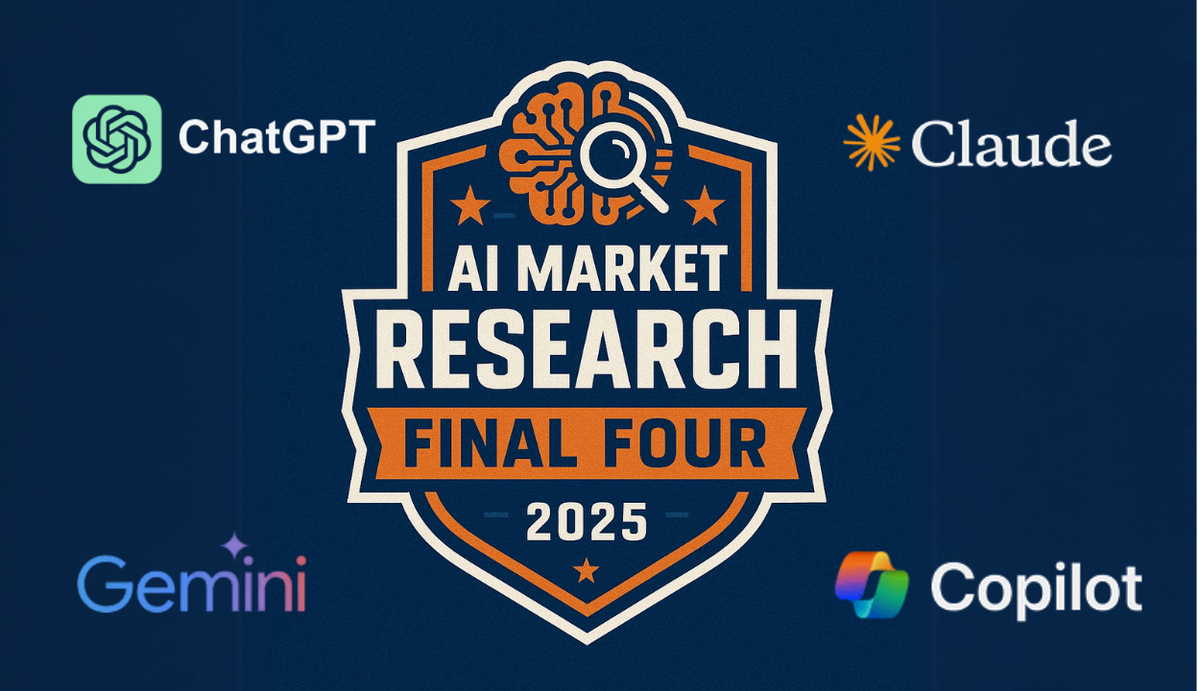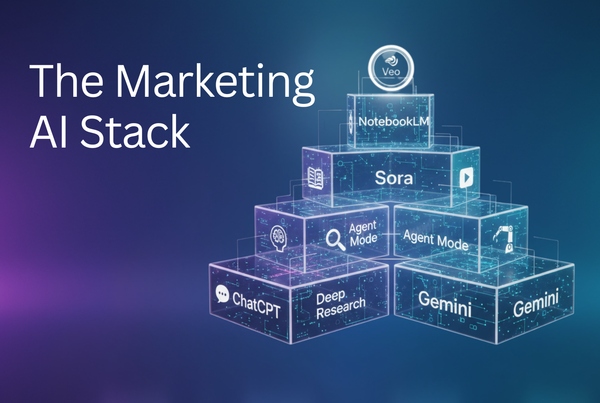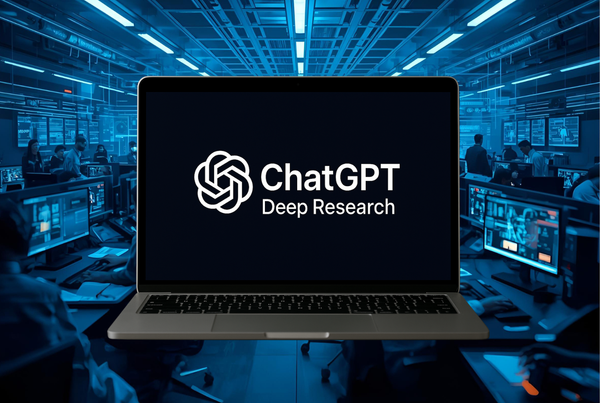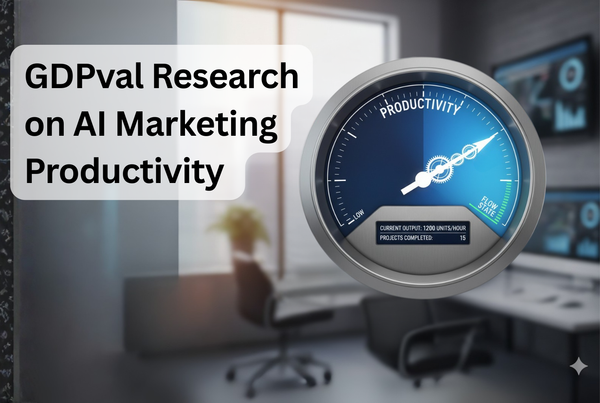AI for DIY Market Research: A Final Four of Top Tools
My Final Four tournament of the top AI tools for a DIY AI market research national champion.

As an SMB marketer, you often have to make decisions without the benefit of a research team or costly market reports. With AI tools, it's now possible to run meaningful, strategic market research using publicly available data. I set out to explore just how far you can go with this DIY approach.
I wanted to create an industry market research report for my company as we head into budget season, while exploring the capabilities of the most popular AI tools: ChatGPT, Claude, Copilot, and Gemini. So I set up a little tournament for my final four tools. I got their help creating a brief and instructions for the project. Then I set up the research with each of them to compared the results. The goal wasn't just to gather insights, but to understand how to leverage what each tool does best.
My thinking is that if I have a clear point of view on the general strengths and weaknesses of each tool, I’ll better know where to turn the next time I need research to support a project, plan, or presentation.
The Road to the Final Four
The tournament contenders included:
- Anthropic's Claude Sonnet 4
- Google Gemini 2.5 Pro
- Open AI ChatGPT-4o
- Microsoft Copilot (Think Deeper setting)
This wasn’t a scientific experiment. I selected these four tools because they are popular and likely where a SMB marketer will begin. I didn’t control for every variable or run peer reviews. My goal was practical: see what a marketer could produce using these free (or close to free) tools. The good news? The results were not only fast, they were rich with data and insight.
Here are some of the common concerns with AI-based research like this:
- Bias and Accuracy: Like any single source, an AI tool can have a bias and introduce blind spots. More on that in this Fast Company article. Comparing multiple tools did help minimize this risk.
- Predictive Limitations: AI is trained on historical data. We don't know how great it is at forecasting shifts in consumer behavior or innovation. More on that in this Harvard Business Review article.
Preparing for Tip-Off
The process began with a detailed project brief. This step was more than just writing a long prompt—it required thinking through exactly what I needed. My brief was a couple pages long and it included:
- Objective and goals of the project
- Target audience for the report
- Market category to analyze, and a subcategory to emphasize
- Geography (U.S. only)
- 10 Key topics to cover, with 3-4 questions to answer for each. Topics included market size, buyer behavior, demand drivers, risks, future outlook, and more.
- Instructions for the data sources to use, format of the report, tone, style, level of detail needed, etc.
I asked each tool to review and refine the brief before the project began. I'm glad I did, the suggestions helped improve the project, even if some went beyond the intended scope.
Game Notes and The Scoreboard
Claude and ChatGPT asked clarifying questions before they started. The others dove right in.
The reports created averaged about 5,000 words—about 20 pages when pasted in Word. I gave each report a generic name, then uploaded all four back into a couple tools to analyze and compare them. Each tool was asked to evaluate the reports for similarities, differences, sophistication, structure, strengths, and weaknesses.
The good news: The market data across the four reports was generally consistent. No tool came back with wildly different figures, which gave me more confidence in the findings. There were distinct difference in their strenghts, when compared to each other.
Yes, each of these can be improved with follow-up prompting to get it where you want to to go. My goal was to see what you get as a starting point, with some suggestions on what you'll expect to see with your tool of choice.
Below is the AI analysis of each report, ranked by their level of sophistication (as determined by the AI tools).
Claude: Sophistication Level: Very High
This report is the strongest and most professionally executed of the four. This study meets or exceeds professional market research standards for a strategic consulting report. The sourcing is meticulous, and the analysis directly supports the conclusions and recommendations.
What it does well:
- Data Rigor and Granularity: This is its greatest strength. It provides specific market sizing figures, growth rates and detailed consumer insights. This level of specificity builds high credibility.
- Actionable Strategic Recommendations: The report excels at translating data into strategy. The recommendations are not only clear but are also segmented by timeline (Immediate, Medium-term, Long-term).
- Comprehensive Persona Development: The buyer personas are exceptionally detailed, covering demographics, financial profiles, emotional triggers, and even a stage-by-stage buyer journey analysis. This provides a deep understanding of the target customer.
Where it is weak:
- Density: Its primary strength, depth, is also a potential weakness. The document is very long and dense, which can be overwhelming and may require a significant time commitment from a C-suite reader.
ChatGPT: Sophistication Level: High
This study is a powerhouse of data presented in a highly unconventional format. The lack of analytical narrative falls short of standards for formal strategic reporting. It's an excellent internal brief.
What it does well:
- Data Density and Synthesis: It is packed with specific data points. Its unique strength is synthesizing multiple sources to create a "National consensus" view.
- Scanability: The use of emojis, bolding, and bullet points makes it incredibly easy to scan and find specific statistics quickly. This format is highly efficient for data retrieval.
- Breadth of Sources: The citation style, while unusual, indicates a wide range of sources were consulted for each data point, adding to the richness of the data presented.
Where it is weak:
- Stylistically inconsistent: Feels like a stitched-together compilation of public stats rather than a single cohesive narrative.
- Limited synthesis: Lacks a strategic executive summary or clear investment-level recommendations.
- Lack of Narrative Depth: The report is more of a collection of facts than a cohesive narrative. While it includes "Implications" and "Summaries," these are brief and lack the detailed strategic discussion.
Co-Pilot: Sophistication Level: Moderate to High
This report is a well-crafted high-level summary, perfect for briefing executives who need to be informed but are short on time.
What it does well:
- Clarity and Conciseness: The report is well-written and gets straight to the point. The executive summary effectively captures the key market dynamics. Its relative brevity makes it highly accessible.
- Logical Structure: It follows a standard, easy-to-follow report structure, moving from market size to buyer personas and competitors in a logical sequence.
- Integrated buyer journey: Maps the stages of decision-making (awareness to decision) with emotional and rational layers.
Where it is weak:
- Lack of Data Specificity: This is its most significant weakness compared to the others. Market data is presented in wide ranges ("$15–20 billion," "8–12% CAGR"), which lacks the authority of specific figures.
- Superficial Analysis: While the analysis is correct, it remains at a high level. The recommendations are somewhat generic ("Invest in Digital Transformation," "Enhance Workforce Capabilities") without the specific "how-to" details in other reports.
- Fewer original insights: Strong on summarizing industry trends but not especially original or forward-looking.
Gemini: Sophistication Level: Moderate
This document is a well-executed summary of the other materials provided. Its primary function is convenience—to provide a single narrative from multiple sources.
What it does well:
- Synthesis: It effectively pulls the main themes from the other reports into a single, coherent document. It correctly identifies the key drivers, challenges, and trends discussed across the source materials.
- Competitive landscape categorization: Groups providers (franchise, tech-enabled, etc.) and outlines positioning well.
Where it is weak:
- Circular and Dependent Sourcing: Its most critical flaw is its reliance on the other documents ("Internal Document") as its sources. From a market research perspective, this is not a research report but a summary or literature review.
- No Original Insight: Because it only synthesizes, it offers no new analysis or data. Its insights are, by definition, a reflection of the other reports. It even explicitly states when information is missing from its sources.
So, Who is Cutting Down the Nets?
Claude brought their "A-game" and won this competition with the most sophisticated report. Each tool brought something different to the table. This is a good thing to keep in mind depending on what you want to get out of your research project. Here’s how AI ranks each based on use case:
| Use Case | Best Tool |
|---|---|
| Strategic Planning | Claude |
| Data-Backed Brief | ChatGPT |
| Executive Summary | Copilot |
| Newcomer-Friendly | Gemini |
MVP Award goes to ChatGPT for creating that awesome logo used in the feature image.





